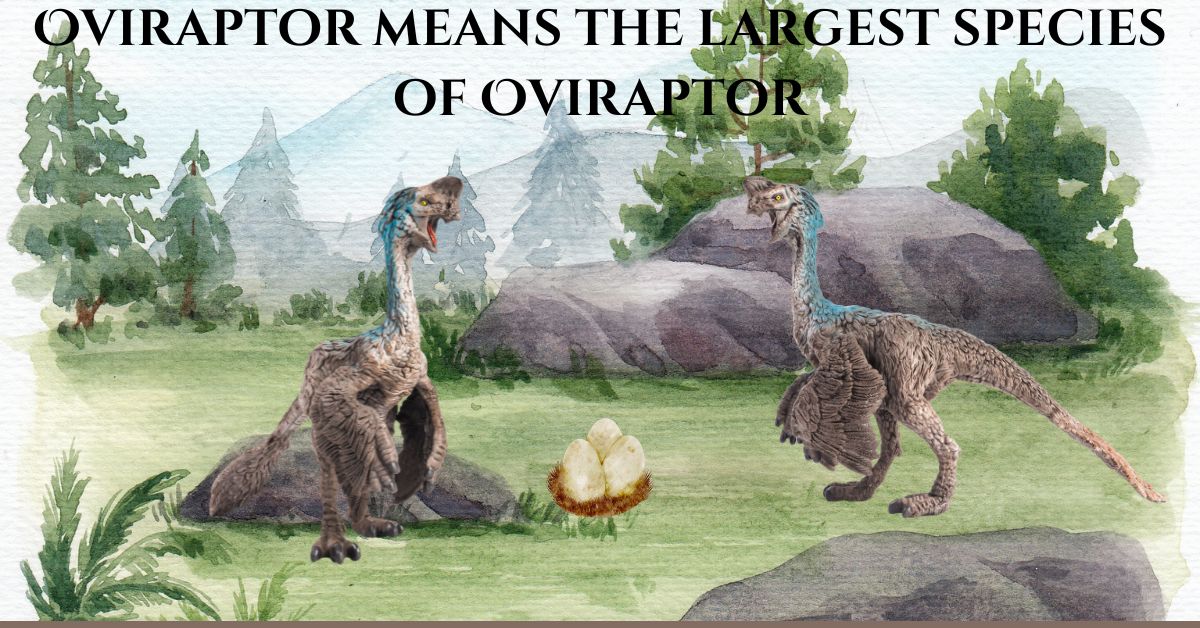Meaning of Oviraptor What is the largest species of Oviraptor?

Introduction
Meaning of Oviraptor What is the largest species of Oviraptor? Oviraptor is a intriguing dinosaur that lived approximately 75 million a long time prior amid the Late Cretaceous period. The title “Oviraptor” implies “egg cheat,” a term determined from the Latin words “ovi” (egg) and “raptor” (cheat or plunderer). This title was given since the to begin with fossil of this dinosaur was found close what were thought to be stolen eggs. In any case, afterward inquire about uncovered that these eggs likely had a place to the Oviraptor itself, driving to a reevaluation of its behavior and lifestyle.
What is an Oviraptor?
Oviraptors were portion of the theropod bunch, characterized by empty bones and three-toed appendages. They were moderately little, with most species measuring around 1.6 meters (around 5 feet) in length. Oviraptors had solid bills, conceivably utilized to split open difficult objects like nuts and shellfish. They too had a unmistakable peak on their heads, which may have been utilized for show purposes or species recognition.
Beginnings of the Name
The to begin with Oviraptor fossil was found in the Gobi Forsake of Mongolia in 1923 by the American Gallery of Normal History endeavor. The example was found on best of a clutch of eggs, driving to the introductory elucidation of the dinosaur as an egg cheat. Consequent discoveries appeared that Oviraptorosaurs, the bunch to which Oviraptor has a place, were really caring parents.
Characteristics of Oviraptor
Oviraptors were little to medium-sized theropods characterized by their particular highlights. They had a beak-like jaw, frequently with no teeth, and a peak on their heads, which changed among species.
Behavior and Diet
The Oviraptor’s slim down is accepted to have been shifted. Prove recommends they ate a combination of plants, little vertebrates, and conceivably eggs. Their settling behavior demonstrates they were caring guardians, brooding over their eggs much like advanced birds.
What is the Biggest Species of Oviraptor?
When inquiring, “What is the biggest species of Oviraptor?“, it’s critical to consider the broader family of Oviraptorosaurs to which Oviraptor has a place. The biggest known species is Gigantoraptor erlianensis.
Discovery and Beginning Misconceptions
The to begin with Oviraptor fossil was found in the 1920s in Mongolia’s Gobi Forsake by the American Historical center of Characteristic History. Paleontologists at first accepted that the Oviraptor was taking eggs from a Protoceratops settle, driving to its title. Be that as it may, encourage revelations, counting a settle with an Oviraptor fossil, proposed that these dinosaurs were really caring for their claim eggs.
Largest Species of Oviraptor
The biggest known species of Oviraptor is Citipati, which implies “burial service fire master” in reference to a figure from Buddhist mythology. Citipati is frequently considered a near relative or indeed a equivalent word of Oviraptor. Citipati examples have been found that degree up to 3 meters (around 10 feet) in length, making it the biggest known part of the Oviraptor family.
Advantages of Examining Oviraptors
Understanding Advancement: Oviraptors give experiences into the advancement of feathered creatures. Their bone structure and settling behavior offer clues approximately the move from non-avian dinosaurs to birds.
Egg Fossils: The revelation of well-preserved egg fossils makes a difference researchers get it dinosaur propagation and development. This incorporates experiences into parental care and hatching practices.
Behavioral Experiences: Examining Oviraptors can uncover behaviors that are not effectively deduced from other dinosaur fossils, such as settling and potential social structures.
Disadvantages of Examining Oviraptors
Fragmentary Fossils: Numerous Oviraptor fossils are inadequate, making it challenging to get a full picture of their science and behavior.
Misinterpretations: Early misinterpretations, like the egg cheat theory, appear how beginning conclusions can be deceiving without total evidence.
Limited Fossil Locales: Oviraptor fossils are basically found in a few areas like Mongolia, restricting the understanding of their worldwide conveyance and diversity.
Table: Comparison of Oviraptor and Citipati
| Feature | Oviraptor | Citipati |
|---|---|---|
| Length | ~1.6 meters (5 feet) | Up to 3 meters (10 feet) |
| Diet | Omnivorous (eggs, plants) | Omnivorous (eggs, plants) |
| Distinctive Feature | Crest on head | Larger crest, longer limbs |
| Fossil Locations | Mongolia | Mongolia |
| Time Period | Late Cretaceous (~75 Mya) | Late Cretaceous (~75 Mya) |
FAQs About Meaning of Oviraptor What is the largest species of Oviraptor?
What does the title Oviraptor mean?
Oviraptor implies “egg thief.”
Where were Oviraptor fossils to begin with discovered?
They were to begin with found in the Gobi Leave of Mongolia.
What was the beginning conviction approximately Oviraptor’s behavior?
It was at first accepted that Oviraptor stole eggs from other dinosaurs.
What is the biggest species of Oviraptor?
The biggest species of Oviraptor is Gigantoraptor erlianensis, which may develop up to 8 meters in length.
How huge was Gigantoraptor?
Gigantoraptor stood around 5 meters tall at the hip and measured around 8 meters in length.
How long might Citipati develop up to?
Citipati might develop up to 3 meters (almost 10 feet) in length.
Conclusion
Oviraptors are a compelling gather of dinosaurs that have captured the intrigued of paleontologists and the open alike. In spite of their starting depiction as egg hoodlums, ensuing investigate has uncovered them to be caring guardians, guarding their homes much like present day fowls. The biggest species, Citipati, encourage highlights the differing qualities inside this bunch. Whereas considering Oviraptors has its challenges, the experiences picked up almost dinosaur behavior, advancement, and regenerative hones make it a beneficial endeavor. By proceeding to explore these old animals, we can reveal more around the interesting world of dinosaurs and their associations to the feathered creatures we see nowadays.